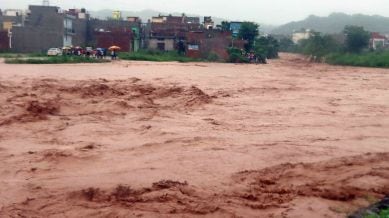Stay updated with the latest - Click here to follow us on Instagram
Why Mohali fears monsoon?
Come rainy season and large parts of Mohali get flooded. What are the reasons for the annual deluge and what can be done to prevent it?

With the monsoon season approaching, residents in parts of the Mohali district are haunted by memories of last year’s floods. Despite efforts by the administration over the past year, such as cleaning drainage systems and purchasing water pumps, it remains a critical test for them to protect people from flooding.
Experts believe that haphazard development and elevated roads in many parts of the district impede smooth water flow. Encroachments on natural water channels are another issue, leading to flooding and water accumulation in residential areas. The de-silting of check dams in the Shivalik foothills and unplanned development have made Mohali particularly prone to flooding.
monthly limit of free stories.
with an Express account.
Former Executive Engineer of the Punjab Urban Development Authority (PUDA), N.S. Kalsi, told The Indian Express that while Mohali was initially planned as a city, uncoordinated development over the years has increased the risk of severe future floods.
Kalsi noted that the height of sector-dividing roads in Mohali has been raised by about 1.5 feet above internal roads, contributing to water-logging. “Previously, sector roads were lower than internal roads to allow unobstructed water flow. In recent years, water-logging has become a major issue. I’ve written numerous letters to civic bodies, but nobody cares,” Kalsi lamented. He also raised concerns about the mismanagement and encroachment of natural water channels, or choes.
Specifically, he pointed out that the Greater Mohali Area Development Authority (GMADA) stone-pitched the bed of the N-choe, which runs through Mohali from Chandigarh, causing 7 to 8-foot tall bushes to grow and disrupt water flow.
“The edges of the choe were cemented, so why wasn’t the bed concreted? It would have maintained the water flow,” Kalsi said, highlighting his repeated but ignored appeals to address this issue.
Kalsi also warned that upcoming elevated roads around Mohali, if not designed with proper water flow considerations, will worsen the flooding situation in the future.
Poor sewerage and drainage
Mohali Deputy Mayor Kuljeet Bedi said that the water-logging issue is significant and there is no foreseeable concrete solution.
He mentioned that three departments (public health, MC, and GMADA) are responsible for the development and maintenance of Mohali’s infrastructure, but unfortunately, there is no coordination between them. He also emphasized that Mohali’s sewerage and drainage systems need immediate overhaul.
Mohali has a total of 217 km of sewerage lines and around 145 km of stormwater lines. Out of 145 km, 77.87 km are brick storm lines and 70.08 km are piped storm lines. Mohali also has a total of 8,593 road gullies, which are essential for water discharge.
Manjeet Singh, former Sub-Divisional Officer of the Public Health department, said that in Mohali, most of the water is discharged into Lakhnaur Choe, which lacks adequate water carrying capacity. He suggested that the concerned departments should consider discharging the water into Patiala Ki Rao rivulet and Phase XI Choe.
De-silting of check dams: A major issue
Around 25 check dams in Mohali district have not been de-silted in the past ten years, posing a major threat to the ecosystem and surrounding villages. Recently, the check dam in Parch, which spans around 88 acres, dried up, leading to the death of birds and animals due to severe heat. Locals pointed out that the dam was not de-silted, reducing its water carrying capacity and causing it to dry up. They also recalled that in 2019, flash floods in Choti Badi Naggal village were caused by a leakage in the Parch Dam due to overflow of water. Despite the district administration raising the issue with the irrigation department in 2019, the de-silting did not occur.
The check dams, located in the foothills of the Shivalik Hills in the New Chandigarh area, were constructed to store water for irrigation purposes. However, tons of earth carried by water flow have accumulated on the bed of the dams.
SDO (Rtd.) Manjeet Singh said that the prolonged delay in de-silting could turn the check dams into a nightmare for the surrounding communities.
Derabassi faces flood threat again
In July last year, during the floods, Derabassi sub-division, including Zirakpur, Lalru, and Handesra areas, was among the worst hit. At least 30 roads were completely damaged, and some bridges were also damaged. This year, the area faces the threat of floods again.
Jaswant Singh Nambardar of Baltana said he has been raising the issue of broken roads and weak banks of the Ghaggar river with the local administration, but to no avail. He alleged that the infrastructure damaged last year was not properly repaired, and now the monsoon is approaching again. Many villages and Gulmohar Extension, a housing society, were submerged during the floods in Ghaggar, with boats being used to rescue trapped people.
Admin claims full preparedness
Deputy Commissioner (DC) Aashika Jain said that the administration is fully prepared to deal with any emergency. She added that a meeting with all the concerned departments was held recently, and officials were instructed to make all the necessary preparations. She also mentioned that the irrigation department was asked to de-silt the dams.